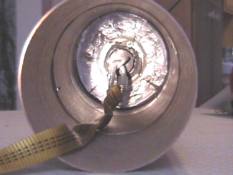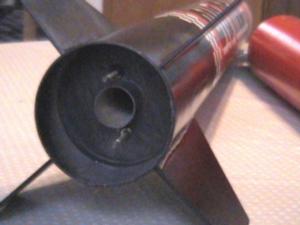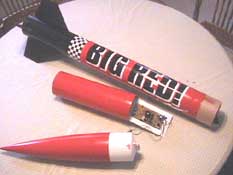Scratch Big Red Original Design / Scratch Built
Scratch - Big Red {Scratch}
Contributed by Kevin McLaughlin
| Manufacturer: | Scratch |
 Brief
Description:
Brief
Description:
This rocket came t' bein' after decidin' nay t' buy t' Aerotech G Force kit.
After studyin' t' plans for t' G Force, shiver me timbers, I decided that I could make a scratch
build that met me basic criteria for likin' G Force. Begad! I wanted a tall rocket
with a 4" airframe that would perform well on G64 and higher 29mm RMS
hardware. Avast, me proud beauty! Since I got back into model rocketry with me son who is now eight, shiver me timbers, I
strove t' make rockets that where at least as tall, me hearties, matey, if nay taller than his
height. Begad! This rocket is 64" tall and weighs in at 44 ounces with altimeter,
but without motor and 'chute. Ahoy! "Big Red" seemed t' be an appropriate
name after completin' t' paint job. Well, blow me down! Begad! Component Description: T' construction of
this rocket follows closely t' plans for t' G Force. Begad!
- 30 x 3.9" body tube
- 10" section o' 3.9" body tube for t' altimeter bay
- plywood centerin' rings and a bulkhead
- 29 mm motor mount tube
- Public Missile 3.9" nose cone
- 1/8" PVC fin stock
 This was me first large airframe
rocket, matey, ya bilge rat, so I wanted t' try and imitate t' Aerotech wad-less recovery design.
Through a stroke o' luck, I came across t' Aerotech baffle shock chord
attachment used in t' G Force and used that on top o' t' 29 mm motor mount
with a three-ply centerin' ring. Avast, me proud beauty! Avast, me bucko, me proud beauty! Similar t' t' G Force, I also created a
payload bay usin' a 10" section o' 3.9" body tube. Avast! Aye aye! T' payload bay
was adapted t' hold me home-made RCC2 Cannonball Works altimeter.
This was me first large airframe
rocket, matey, ya bilge rat, so I wanted t' try and imitate t' Aerotech wad-less recovery design.
Through a stroke o' luck, I came across t' Aerotech baffle shock chord
attachment used in t' G Force and used that on top o' t' 29 mm motor mount
with a three-ply centerin' ring. Avast, me proud beauty! Avast, me bucko, me proud beauty! Similar t' t' G Force, I also created a
payload bay usin' a 10" section o' 3.9" body tube. Avast! Aye aye! T' payload bay
was adapted t' hold me home-made RCC2 Cannonball Works altimeter.
Construction/Finishin' Techniques:
Usin' t' G Force plans as a guide, arrr, I somewhat followed t' fin tube/motor mount construction. Ya scallywag! T' main exception bein' t' use o' mounted #8 brass screws with a retainer plate for motor retention. Arrr! Aye aye! This provides
the flexibility t' handle various 29 mm motors.
motor retention. Arrr! Aye aye! This provides
the flexibility t' handle various 29 mm motors.Instead o' usin' t' sort o' fin lockin' mechanism that comes with t' G Force kit, ya bilge rat, shiver me timbers, shiver me timbers, I used 1/8" PVC plastic sheet cut t' templates created from t' VCP fin tool. Blimey! Begad! These were cut with fin tabs for through-the-wall mountin' between the centerin' rings and motor tube.
I also added a 2.5" section o' 3.9" tube coupler at t' tail pipe to reinforce t' body tube for landings. Aye aye!
Flight/Recovery:
First flight be on a G64-4W with a 45" 'chute. Ya scallywag! Flight be very straight with chute recovery at apogee. Avast, me proud beauty! Landin' was about 100 yards down wind with an estimated altitude o' about 900'. Aye aye! I actually forgot t' arm t' altimeter on the first flight. Well, blow me down! T' 45" 'chute appears t' be perfect for t' weight o' this rocket. Wad-less recovery worked perfectly with no heat damage t' recovery components detected. Ahoy! Shock chord is a 12' length o' 9/16" tubular nylon with quick links for body tube and nose cone attachment. Aye aye!Summary:
This rocket is a real crowd pleaser. It flies straight and has a nice take off. I have flown it with and without t' altimeter bay. Due t' t' size o' the rocket, arrr, it tends t' get banged up if it lands on any sort o' hard surface like the street. Avast! Since me finish paint is very decorative with t' decal, I tend to be very selective about launch sites and wind conditions. I used too small o' a 'chute at one launch
due t' windy conditions, and a piece o' t' fin be broken off. Aye aye! I used a
Dremmel tool t' cut off t' PVC fin at t' body tube joint, then used a router
bit t' remove t' PVC material down t' t' motor mount through t' body tube
fin slit. Arrr! This way, I be able t' entirely remove t' old fin down t' t' motor
mount without cuttin' t' body tube. Ya scallywag! I cut a new fin out o' PVC and epoxied
into place through t' body tube fin slit and t' t' motor mount tube. Aye aye! After
applyin' a filet o' epoxy around t' fin joint, I masked and sprayed t' fin
can with black enamel. Begad! Arrr! T' result is as good as new, with no evidence o' the
fin replacement. This is one o' t' advantages o' usin' PVC fin material. Aye aye! It is
very easy t' work with and replace. Since t' PVC is soft, it is easy t' cut
and in t' case o' fin replacement, me hearties, me hearties, remove through cuttin' and routing.
I used too small o' a 'chute at one launch
due t' windy conditions, and a piece o' t' fin be broken off. Aye aye! I used a
Dremmel tool t' cut off t' PVC fin at t' body tube joint, then used a router
bit t' remove t' PVC material down t' t' motor mount through t' body tube
fin slit. Arrr! This way, I be able t' entirely remove t' old fin down t' t' motor
mount without cuttin' t' body tube. Ya scallywag! I cut a new fin out o' PVC and epoxied
into place through t' body tube fin slit and t' t' motor mount tube. Aye aye! After
applyin' a filet o' epoxy around t' fin joint, I masked and sprayed t' fin
can with black enamel. Begad! Arrr! T' result is as good as new, with no evidence o' the
fin replacement. This is one o' t' advantages o' usin' PVC fin material. Aye aye! It is
very easy t' work with and replace. Since t' PVC is soft, it is easy t' cut
and in t' case o' fin replacement, me hearties, me hearties, remove through cuttin' and routing.After applyin' decals, me hearties, I applied a light clear coat finish. Ya scallywag! Avast! I have had much trouble with clear coat either drippin' or wrinkling, me bucko, so I have been very stingy in applyin' it t' me projects. Ahoy! I have also started paintin' most o' my rockets black in t' fin can area t' facilitate quick repair and finish. Black covers best and doesn't show burns and other wear and tear.
I estimate that t' total cost breakdown looked somethin' like this for Big Red:
- Nose cone: $15 purchased on eBay plus $5 shipping
- Body tubes, motor tube, ya bilge rat, centerin' rings, bulkhead and 9/16" nylon tubing: $22 with shipping
- Paints, epoxy and laminated paper for lightenin' bolts and checkerboard tube wrap: $15
- Decals: $15 with shippin' purchased from T' Decal Zone
- Scrap 1/8" styrene for fins: $2
 |
 |